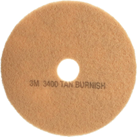
Not all floor pads are made the same—there’s a strategy behind sustainability. Using the appropriate tools for the task at hand is simple but essential advice that applies to many fields. The right tools not only guarantee a job done well, but also boost efficiency and reduce costs. This concept holds true for floor maintenance, where keeping floors clean, safe, and visually appealing demands a commitment to quality. Whether stripping, cleaning, or polishing floors, floor pads play a crucial role in achieving excellent results.
Floor pads
Stripping pads
Properly stripping your floor before applying a finish is essential to achieving the desired outcome.

Scrubbing pads
Scrubbing pads are crafted for efficient, consistent maintenance of both protected and unprotected floors, helping to remove dirt and black marks. They can enhance shine or simply keep unprotected floors in excellent condition.


Cleaning pads
For routine cleaning of high-traffic floors, scrubbing pads can be used with a scrubber dryer or a single-disc machine and a spray cleaner to effectively remove light soil and other contaminants.


Burnishing pads
Also known as polishing pads, they are designed to create a shine on newly coated floors and restore the gloss of protected floors.




There are three main components in a floor pad:
1. Fibre: This forms the core of the pad and can vary by manufacturer. Open fibre construction is ideal as it reduces clogging and enhances dirt pickup, leading to a more efficient clean.
2. Abrasive: This mineral embedded in the pad is crucial for cleaning effectiveness. It helps to scrub and remove dirt from the floor surface.
3. Resin: The adhesive that bonds the abrasive mineral to the fibre. This component is vital for maintaining the pad's integrity during use.
Together, these elements ensure the pad performs well. High-quality materials are crucial, especially when using various cleaning solutions. Inferior pads can deteriorate when exposed to chemicals, leading to ineffective cleaning and additional costs for rework. Investing in quality pads helps avoid these issues and ensures better, longer-lasting results.
What makes a good floor pad?
High-quality floor pads have consistent abrasive mineral density throughout, ensuring uniform cleaning performance as the pad wears. If sliced horizontally, the abrasive minerals are evenly distributed from the center to the edges. This consistency maintains the pad’s effectiveness over its entire lifespan. In contrast, low-quality pads have less abrasive material inside, leading to reduced performance as they wear down.


*The high performance microscopic diagram is based on 3M floor pads
Durable solution for a sustainable future
Floor pads can create a lot of waste, so choosing durable ones that last longer is important. 3M Floor Pads are Green Seal Certified, meaning they meet high standards for performance, health, and environmental impact. This certification helps ensure that you’re choosing eco-friendly products that are both effective and sustainable.

